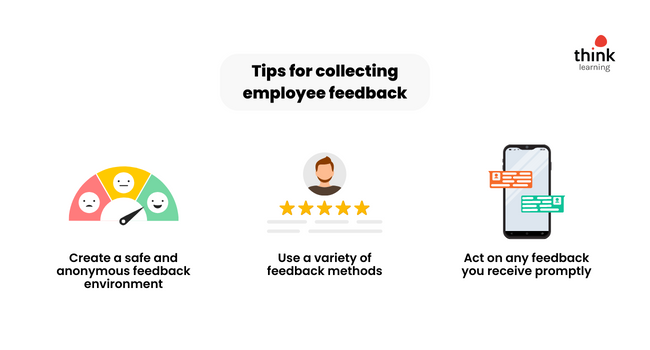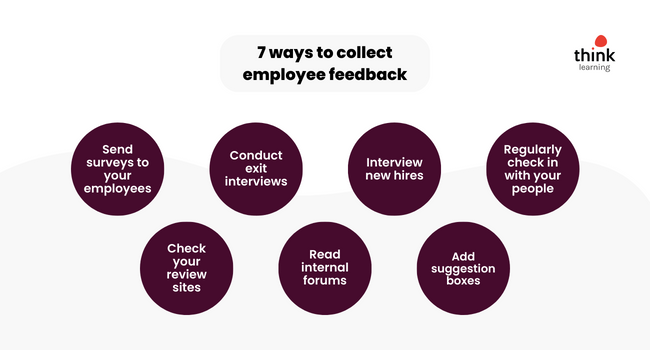
Employee feedback is a key way to tailor your L&D strategy, as you can focus in on what truly matters to your team.
Employee feedback is like gold dust for L&D professionals.
It provides a deep insight into your audience’s thoughts and feelings, letting you know what they care about most.
This level of understanding about your employees will impact and influence your learning provision, ultimately making your entire offering more successful.
In this blog we’re going to explore:
- What employee feedback really is
- Why you should collect it
- Give you seven methods of sourcing feedback in your organisation
Let’s get started.
What is employee feedback?
Feedback is defined as “information or statements of opinion about something that can tell you if it is successful or liked”.
This information is typically used as a basis for improvement, particularly in a workplace environment.
So, when we’re looking at employee feedback, we’re considering the discourse between employees and leadership at an organisation.
Although many will assume employee feedback is from leadership to employees, it should be a two-way conversation. And it’s having an understanding of both sides of the conversation that is particularly useful to learning teams.
Why collecting employee feedback is important for L&D
In order to truly serve their target audience, L&D must have a deep understanding of their employee’s wants, needs and pain points.
Armed with this information, learning teams can tailor their offering to their audience’s needs, and ultimately boost learning efficacy for the organisation.
For example, if employee feedback reveals that people want more support with their career growth and prospects, L&D could:
- Create or curate training for managers on how to have career-enhancing conversations with their team
- Develop skills-based learning plans
- Provide resources to help them determine what their career growth may look like and what skills they will need to succeed.
However, without talking to your target audience, how can you tailor your learning in this way?
The truth is, employee feedback is critical for learning that works for both the organisation and the learner.
When to ask for employee feedback
Asking employees for feedback is an important practice that should be done at various stages and instances to ensure a continuous improvement cycle within an organisation.
Firstly, it is essential to ask for feedback during the onboarding and training period.
New employees have a fresh perspective on the company’s processes and procedures and can provide valuable insights on areas that may need improvement or clarification.
This early feedback can help refine the onboarding process and set the stage for a positive and productive employee experience.
Secondly, regular check-ins and performance evaluations are crucial moments to ask employees for feedback.
These meetings provide an opportunity for employees to share their thoughts on their work, challenges faced, and suggestions for improvement.
It allows managers to understand the needs and concerns of their team members and make necessary adjustments to support their professional growth and wellbeing.
By actively seeking feedback on a regular basis, organisations can foster a culture of open communication, trust, and collaboration, leading to higher employee satisfaction and engagement.
Tips to ask for employee feedback
Before you get started with setting up methods of collecting employee feedback, there are some things to take note of.
Not every employee will feel comfortable sharing feedback with you. Or, they might prefer one method over another.

So, here’s are three quick tips for collecting employee feedback:
Create a safe and anonymous feedback environment
It is essential to create a safe environment where employees feel comfortable sharing their thoughts and concerns. One way to achieve this is by providing an anonymous feedback platform where employees can express themselves without fear of retribution. This can lead to more accurate and honest feedback without worrying about retaliation or judgment.
Use a variety of feedback methods
Collecting feedback through various channels can provide a more comprehensive understanding of employee perception. Use a mix of methods, such as surveys, interviews, suggestion boxes, focus groups, or one-on-one meetings, to gather a diverse range of perspectives. This variety can help identify patterns and common themes in feedback, leading to better decision-making.
Act on feedback
Collecting feedback is critical, but it is equally essential to act on it. Show appreciation for the feedback shared by employees by implementing changes and improvements based on their suggestions. Communicate these changes across the organization and discuss how employee feedback contributed to the decision-making process. This way, employees feel heard, valued, and understand the impact of their feedback, leading to increased trust, motivation, and engagement in the workplace.
7 ways to collect employee feedback
So now we know why employee feedback is so important, here are seven ways in which you can collate this feedback in your organisation:

- Send surveys to your employees
- Conduct exit interviews
- Interview new hires
- Regularly check in with your people
- Check your review sites
- Read internal forums
- Add suggestion boxes
Let’s look at each of these in a little bit more detail.
1. Send surveys to your employees
Surveys are one of the most effective ways of garnering feedback from employees, particularly as they are usually anonymous.
This gives your employees the freedom to voice their opinions, with no fear of repercussions.
There are a few ways to survey your people, and the most popular are:
- Yearly or bi-annual surveys: Many organisations send out surveys on a semi-regular basis. This enables you to get a good understanding of how your employees are feeling at a specific moment in time. Plus, you can adapt the questions each year to your needs.
- Pulse surveys: These surveys are much more regular than other employee surveys. With a pulse survey you ask your employees about the same topic every time, they have fewer questions and happen at a regular time interval. For example, you would send pulse surveys on a monthly or quarterly basis.
2. Conduct exit interviews
When employees are leaving your organisation, they are likely to feel more confident about airing their views and opinions.
The information you discover in these interviews will tell you a lot about your organisation, such as your culture, management and employee expectations.
And although it may be too late to get those employees to stay, this information can be critical to the ongoing success of your L&D function.
3. New hire interviews
Exit interviews might be commonplace in your organisation, but are new hire interviews?
And we don’t mean the interview process before they accept your offer – we’re talking about interviewing them after they’ve joined your organisation.
This is a great time to set expectations and find out what your new employees really want and need from your L&D function.
Plus, if you already have learning resources that cater to their needs, this is a great time to sign-post them to the relevant places.
4. Interview your people
We’ve spoken about people who are leaving your organisation, and those who have just joined. But what about those in between?
The people who’ve been working at your organisation a while, how do you hear their voices?
If you want to truly engage with your audience, choosing a subset to interview is a great approach to take.
It’s a good idea to have these interviews in a safe environment, and assure your employees that what they say will stay between you and them.
This will give them the confidence to be completely transparent with you, and as such, further improve your understanding of your target audience.
5. Check out review sites
When people look for employee feedback, they often look internally.
So, it might surprise you that we’re recommending looking at external review sites.
However, sites like Glassdoor are fantastic for finding out how your employees really feel.
Of course, this feedback will not give you answers to specific questions. But it will provide you with a good sentiment analysis of how your people are feeling and may give you some good pointers for improvement.
6. Read internal forums
As well as external review sites, your internal channels are a great place to find employee feedback.
This feedback will be less overt than surveys or interviews, but it will be truly valuable to your L&D division.
For example, if you have Workplace, Slack or a discussion forum on your LMS, look at what people are talking about.
What questions are they asking? Are they struggling with things where your learning offering can help? If so, use this to tailor your learning communications to help them find the resources they need.
7. Add suggestion boxes
Retaining employee anonymity is one of the best ways to get honest feedback.
So, a suggestion box is sometimes a fantastic route for organisations to take.
Suggestion boxes allow employees to give their input regarding working conditions, processes, HR, benefits, colleagues or managers. This is a great way to make employees feel involved, boost morale and boost innovation in the workplace.
And if you have a remote team, there are a lot of digital suggestion boxes that you can utilise and still get the same impact!
Using technology to facilitate the employee feedback process
Often in organisations feedback is only given from one person to another.
Not only does this mean valuable data can live in departmental silos. It also opens your feedback up to be biassed and filled with personal opinions – no matter how hard you try.
360-performance reviews overcome this by asking multiple people to provide feedback on one employee’s performance.
For example, their direct manager, teammates and colleagues from other departments.
Looking at this example from our friends at Totara shows the real impact of 360-performance reviews:
Jenna is an assistant on your team. She is quiet and hasn’t especially stood out to you as her manager. In her 360 feedback, her colleagues have praised her for her quick thinking, positive attitude and problem-solving skills, and another manager has suggested that her talents may have been overlooked.
This approach to providing feedback not only ensures your employees are excelling in the way you’d hope, but also provides you a level of understanding about your workplace than a more ‘traditional’ feedback process.
Start collecting employee feedback with Think Learning
When it comes to garnering feedback from your employees, technology can come in very useful.
Within the Think Learning LMS, there are a number of ways to facilitate the employee feedback process, including our bespoke 360 feedback tool, appraisals and automation.
To learn more about our LMS, book a demo now and to learn how our appraisal tool works in real-life, check out this case study about Circle Health Group.

